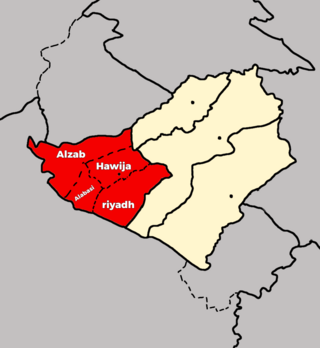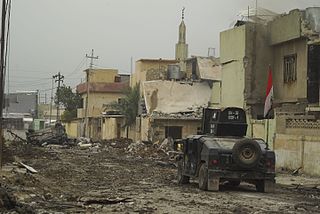
Hawija is the central town of Al-Hawija District in the Kirkuk Province of Iraq, 45 km (28 mi) west of Kirkuk, and north of Baghdad. The town has a population of about 480,000 inhabitants.
The 2008 Nineveh campaign was a series of offensives and counter-attacks between insurgent and Coalition forces for control of the Nineveh Governorate in northern Iraq in early-to-mid-2008. Some fighting also occurred in the neighboring Kirkuk Governorate.

Hawija District is a district in Kirkuk Governorate, Iraq. Its administrative center is the city of Hawija.

The disputed territories of northern Iraq are regions defined by article 140 of the Constitution of Iraq as being Arabised during Baath Party rule in Iraq. Most of these regions are inhabited by non-Arabs, including Kurds, Assyrians, Yazidis, Turkmens/Turkomans, and Shabaks.

The 2012–2013 Iraqi protests started on 21 December 2012 following a raid on the home of Sunni Finance Minister Rafi al-Issawi and the arrest of 10 of his bodyguards. Beginning in Fallujah, the protests afterwards spread throughout Sunni Arab parts of Iraq. The protests centered on the issue of the alleged sectarianism of Prime Minister Nouri al-Maliki. Pro-Maliki protests also took place throughout central and southern Iraq, where there is a Shia Arab majority. In April 2013, sectarian violence escalated after the 2013 Hawija clashes. The protests continued throughout 2013, and in December Maliki used security forces to forcefully close down the main protest camp in Ramadi, leaving at least ten gunmen and three policemen dead in the process.
The 2013 Hawija clashes relate to a series of violent attacks within Iraq, as part of the 2012–2013 Iraqi protests and Iraqi insurgency post-U.S. withdrawal. On 23 April, an army raid against a protest encampment in the city of Hawija, west of Kirkuk, led to dozens of civilian deaths and the involvement of several insurgent groups in organized action against the government, leading to fears of a return to a wide-scale Sunni–Shia conflict within the country. By 27 April, more than 300 people were reported killed and scores more injured in one of the worst outbreaks of violence since the U.S. withdrawal in December 2011.
From 15 to 21 May 2013, a series of deadly bombings and shootings struck the central and northern parts of Iraq, with a few incidents occurring in towns in the south and far west as well. The attacks killed at least 449 people and left 732 others injured in one of the deadliest outbreaks of violence in years.

The War in Iraq was an armed conflict between Iraq and its allies and the Islamic State. Following December 2013, the insurgency escalated into full-scale guerrilla warfare following clashes in the cities of Ramadi and Fallujah in parts of western Iraq, and culminated in the Islamic State offensive into Iraq in June 2014, which lead to the capture of the cities of Mosul, Tikrit and other cities in western and northern Iraq by the Islamic State. Between 4–9 June 2014, the city of Mosul was attacked and later fell; following this, Prime Minister Nuri al-Maliki called for a national state of emergency on 10 June. However, despite the security crisis, Iraq's parliament did not allow Maliki to declare a state of emergency; many legislators boycotted the session because they opposed expanding the prime minister's powers. Ali Ghaidan, a former military commander in Mosul, accused al-Maliki of being the one who issued the order to withdraw from the city of Mosul. At its height, ISIL held 56,000 square kilometers of Iraqi territory, containing 4.5 million citizens.
The following lists events that happened during 2014 in Iraq.

The Shirqat offensive, codenamed Operation Conquest or Operation Fatah, was an offensive against the positions of the Islamic State of Iraq and the Levant (ISIL) in and around the district of Al-Shirqat District to reach the city of Mosul.
The Battle of Hit, code named Operation Desert Lynx by Iraqi forces, was an offensive launched by the Iraqi Government during the Anbar offensive, with the goal of recapturing the town of Hīt and the Hīt District from ISIL. After the Iraqi forces recaptured the city of Ramadi, Hīt and Fallujah were the only cities still under the control of ISIL in the Al Anbar Governorate. Iraqi Forces fully recaptured of Hīt and the rest of the Hīt District on 14 April 2016.
This is a timeline of events during the War in Iraq in 2016.
This is a timeline of events during the War in Iraq of 2013 to 2017 in its final year.
The Battle of Tal Afar was an offensive announced on 20 August 2017 by Iraqi Prime Minister Haider al-Abadi in order to liberate the Tal Afar region from the Islamic State of Iraq and the Levant (ISIL). Victory in the battle was declared by the Prime Minister al-Abadi following the capture of the last ISIL-held area in Tal Afar district.

The 2017 Western Iraq campaign was the final major military operation of the 2013–2017 war in Iraq, in the western province of Anbar, and on the border with Syria, with the goal of completely expelling ISIL forces from their last strongholds in Iraq.

The Battle of Hawija was an offensive launched in September 2017 by the Iraqi Army, in order to recapture the town of Hawija and the surrounding areas from the Islamic State of Iraq and the Levant (ISIL).
The Western Anbar offensive (2017) was a military operation by the Iraqi Army against the Islamic State of Iraq and the Levant, in the western districts of the Province of Anbar and on the border with Syria.
This is a timeline of events during the Islamic State insurgency in Iraq (2017–present) in 2019.
This is a timeline of events during the Islamic State insurgency in Iraq (2017–present) in 2018.








